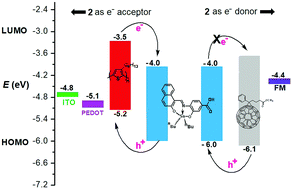One-pot microwave-assisted synthesis of organotin Schiff bases: an optical and electrochemical study towards their effects in organic solar cells†
Abstract
Four organotin compounds bearing Schiff bases were prepared via a multicomponent microwave-assisted reaction among 2-hydroxy-1-naphthaldehyde, 2-aminophenol derivatives and the corresponding diorganotin oxide (R2SnO, R = nBu or Ph), with high yields and a low economic/environmental impact. All of the compounds were fully characterized by NMR (1H, 13C, and 119Sn) spectroscopy, high-resolution mass spectrometry, X-ray diffraction, cyclic voltammetry, UV/Vis spectroscopy, and fluorescence spectroscopy. All of the compounds absorb in the visible region around 480–490 nm, close to the maximum solar emission, with an optical band gap of around 2.3 eV and low fluorescence quantum yields. According to the electrochemical study, they present LUMO values close to that of [6,6]-phenyl-C61-butyric acid methyl ester (PCBM-C60), a typical electron acceptor organic photovoltaic material. Based on this combined optical/electrochemical study and as it allows the preparation of homogeneous spun films, the n-butyltin complex with carboxylic acid was selected for the investigation of its possible photovoltaic properties in organic solar cells. Charge photogeneration was obtained only using this organotin compound as an electron acceptor material with poly(3-hexylthiophene, P3HT) (typical electron donor material) with an open circuit voltage of 300 mV, a short-circuit current density of 0.11 mA cm−2 and an efficiency of 5.2 × 10−3%. Despite the fact that the efficiency is much lower with respect to the reference device P3HT/PCBM-C60, this preliminary result suggests that, after chemical and device processing optimization, tin complexes with Schiff bases could be applied as electron acceptor materials in organic photovoltaic devices.



 Please wait while we load your content...
Please wait while we load your content...